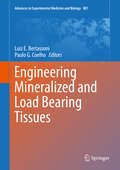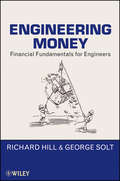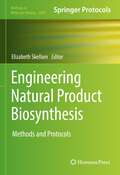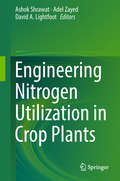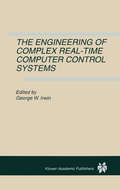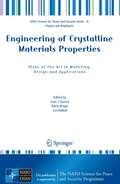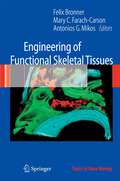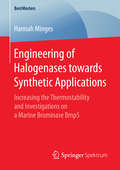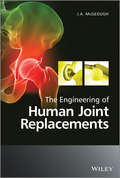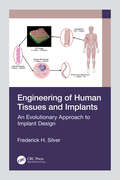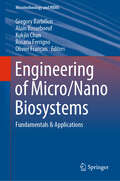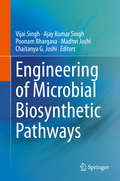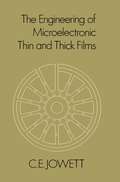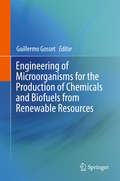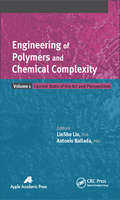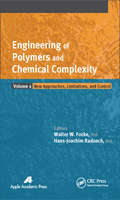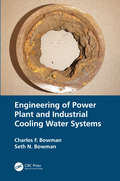- Table View
- List View
Engineering Mineralized and Load Bearing Tissues (Advances in Experimental Medicine and Biology #881)
by Luiz E. Bertassoni Paulo G. CoelhoThis book offers a comprehensive overview of current challenges and strategies to regenerate load-bearing and calcified human tissues, including bone, cartilage,tendon, ligaments and dental structures (dentin, enamel, cementum and periodontal ligament). Tissue engineering has long held great promises as an improved treatment option for conditions affecting mineralized and load-bearing structures in the body. Although significant progress has been achieved in recent years, a number of challenges still exist.Scaffold vascularization, new biofabrication methods (3D printing, lithography, microfabrication), peptide conjugation methods, interface engineering, scaffold mechanical properties, iPS cells, organs-on-a-chip, are some of the topics discussed in this book. More specially, in the first section readers will find an overview of emerging biofabrication methods. In section 2, applied strategies for regeneration of (2.1) bone, cartilage and ligament, as well as (2.2) dentin, cementum, enamel and periodontal ligament are discussed across 14 chapters.While other volumes have addressed the regeneration of individual tissues, or exclusively focused on different regenerative strategies, the focus of this work is to bring together researchers integrating backgrounds in materials sciences, engineering, biology, mechanics, fluidics, etc, to address specific challenges common to regeneration of several load-bearing and calcified tissues. Therefore, this book provides a unique platform to stimulate progress in the regeneration of functional tissue substitutes.We envision that this book will represent a valuable reference source for university and college faculties, post‐doctoral research fellows, senior graduate students, and researchers from R&D laboratories in their endeavors to fabricate biomimetic load bearing tissues.
Engineering Money: Financial Fundamentals for Engineers
by Richard Hill George SoltThere are many text books about engineering design and some include project evaluation techniques. There are text books on accounting methods and yet others on business management. This book does not aim to replace these specialized texts but brings together the elements of these subjects that young engineers working in industry – particularly the construction industry and its customers – need to understand. Most engineers learn about money the hard way: by experience in the workplace. The authors having done this themselves recognized the gap in engineers’ education and set out to bridge it. This book is based on a 1996 course George Solt pioneered for final-year engineering undergraduates. The book is written in an approachable style and gives young engineers as well as mature engineers an insight into the way engineering businesses run, the importance of capital and the problems of cash flow.
Engineering Money: Financial Fundamentals for Engineers
by Richard Hill George SoltThere are many text books about engineering design and some include project evaluation techniques. There are text books on accounting methods and yet others on business management. This book does not aim to replace these specialized texts but brings together the elements of these subjects that young engineers working in industry – particularly the construction industry and its customers – need to understand. Most engineers learn about money the hard way: by experience in the workplace. The authors having done this themselves recognized the gap in engineers’ education and set out to bridge it. This book is based on a 1996 course George Solt pioneered for final-year engineering undergraduates. The book is written in an approachable style and gives young engineers as well as mature engineers an insight into the way engineering businesses run, the importance of capital and the problems of cash flow.
Engineering Natural Product Biosynthesis: Methods and Protocols (Methods in Molecular Biology #2489)
by Elizabeth SkellamThis volume highlights natural products, molecular methods for identifying, and current trends in designing non-natural natural products. Chapters guide readers through protocols on heterologous expression techniques, gene disruption, modified pathway regulators, and in-vitro studies. Written in the format of the highly successful Methods in Molecular Biology series, each chapter includes an introduction to the topic, lists necessary materials and reagents, includes tips on troubleshooting and known pitfalls, and step-by-step, readily reproducible protocols. Authoritative and cutting-edge, Engineering Natural Product Biosynthesis: Methods and Protocols aims to be a useful and practical guide to new researchers and experts looking to expand their knowledge. Chapter 13 is available open access under a Creative Commons Attribution 4.0 International License via link.springer.com.
Engineering Nitrogen Utilization in Crop Plants
by Ashok Shrawat Adel Zayed David A. LightfootThis book discusses and addresses the rapidly increasing world population demand for food, which is expected to double by 2050. To meet these demands farmers will need to improve crop productivity, which relies heavily on nitrogen (N) fertilization. Production of N fertilizers, however, consumes huge amounts of energy and the loss of excess N fertilizers to leaching results in the pollution of waterways and oceans. Therefore, increasing plant nitrogen use efficiency (NUE) is essential to help farmers produce more while conserving the environment. This book assembles some of the best work of top researchers from academic and industrial institutions in the area of NUE and provides valuable insight to scholars and researchers by its comprehensive discussion of current and future strategies to improve NUE through genetic manipulation. This book should also be highly valuable to policy makers, environmentalists, farmers, biotechnology executives, and to the hard-core researchers working in the lab.
The Engineering of Complex Real-Time Computer Control Systems
by George W. IrwinThe Engineering of Complex Real-Time Computer Control Systems brings together in one place important contributions and up-to-date research results in this important area. The Engineering of Complex Real-Time Computer Control Systems serves as an excellent reference, providing insight into some of the most important research issues in the field.
Engineering of Crystalline Materials Properties: State of the Art in Modeling, Design and Applications (NATO Science for Peace and Security Series B: Physics and Biophysics)
by Juan J. Novoa Dario Braga Lia AddadiThis volume collects the state of the art in molecular materials. It collects the lecture notes of a series of lectures given by some of the best specialists in the field at the 2007 Erice International School of Crystallography, and also a NATO-ASI course. The school first established "where we are" in terms of modeling, design, synthesis and applications of crystalline solids with predefined properties and then defined current and possible futuristic lines of development.
Engineering of Functional Skeletal Tissues (Topics in Bone Biology #3)
by Felix Bronner Mary C. Farach-Carson Antonios G. MikosThis is the 3rd volume in a series of reviews centered on the single major topic of bone replacement, discussing the biology of stem cells and cell signals, the knowledge needed to make stem cell-engineered bone tissue a reality, and how to prevent bone allograft infection. Useful as a followup to its predecessors, and as a stand-alone reference, it will interest a broad audience from orthopedists and bioengineers to dentists.
Engineering of Halogenases towards Synthetic Applications: Increasing the Thermostability and Investigations on a Marine Brominase Bmp5 (BestMasters)
by Hannah MingesHannah Minges focuses on the investigation of two different FAD-dependent halogenases in order to analyze and improve their applicability for chemoenzymatic approaches in chemistry. Owing to beneficial features, like high selectivity and benign reaction conditions, nature’s toolkit for halogenation provides several advantages, whereas conventional chemical strategies require hazardous reagents and suffer from low selectivity. Therefore, enzymatic halogenation arises as promising alternative in the synthesis of valuable chemicals. One project focuses on the generation of a thermostable variant of the tryptophan halogenase Thal by means of directed evolution. The second project deals with the investigation of the marine halogenase Bmp5. This enzyme is of synthetic interest because it preferably introduces bromine into phenol compounds, whereas chlorination cannot take place.
The Engineering of Human Joint Replacements
by J. A. McGeoughSince the major pioneering of joint replacement surgery more than fifty years ago, much research and progress has been made in the field of arthroplasty with new insights into better materials, types of cement and bone-cell compatible coatings, and a better understanding of the causes of implant failure. With an increasingly ageing population the requirement for arthroplastic surgery is manifest; over 800,000 hips worldwide are replaced each year, and replacement surgery is performed for almost every joint of the body. The Engineering of Human Joint Replacements covers the design, engineering, production and manufacture of human joint replacements, as well as associated engineering concerns such as surface coatings, orthopedic bone cement, the causes and effects of wear and tear, and rapid prototyping for clinical evaluation. Materials evaluation and selection is discussed, as well as production processes and insertion methods. The author provides an overview of skeletal anatomy and the effects of pain and deterioration in order to put the engineering principles into a medical context. Examples of joint replacements for the most common regions of the body are included, and aspects of clinical studies of these cases are discussed. Key Features: • Provides an overview of the engineering materials and processes involved in the manufacture of human joint replacements • Sets the scene for engineers and clinicians embarking on research into joint replacements • Includes clinical and industrial examples and points the way to future developments • Provides information on medical device companies with an engineering guide to the requirements for joint replacement The Engineering of Human Joint Replacements bridges the divide between engineering and orthopaedic surgery, offering an introductory text to young engineers entering the field, as well as a reference for medical staff who will benefit from an understanding of the materials and methods used in their design, engineering and manufacture.
The Engineering of Human Joint Replacements
by J. A. McGeoughSince the major pioneering of joint replacement surgery more than fifty years ago, much research and progress has been made in the field of arthroplasty with new insights into better materials, types of cement and bone-cell compatible coatings, and a better understanding of the causes of implant failure. With an increasingly ageing population the requirement for arthroplastic surgery is manifest; over 800,000 hips worldwide are replaced each year, and replacement surgery is performed for almost every joint of the body. The Engineering of Human Joint Replacements covers the design, engineering, production and manufacture of human joint replacements, as well as associated engineering concerns such as surface coatings, orthopedic bone cement, the causes and effects of wear and tear, and rapid prototyping for clinical evaluation. Materials evaluation and selection is discussed, as well as production processes and insertion methods. The author provides an overview of skeletal anatomy and the effects of pain and deterioration in order to put the engineering principles into a medical context. Examples of joint replacements for the most common regions of the body are included, and aspects of clinical studies of these cases are discussed. Key Features: • Provides an overview of the engineering materials and processes involved in the manufacture of human joint replacements • Sets the scene for engineers and clinicians embarking on research into joint replacements • Includes clinical and industrial examples and points the way to future developments • Provides information on medical device companies with an engineering guide to the requirements for joint replacement The Engineering of Human Joint Replacements bridges the divide between engineering and orthopaedic surgery, offering an introductory text to young engineers entering the field, as well as a reference for medical staff who will benefit from an understanding of the materials and methods used in their design, engineering and manufacture.
Engineering of Human Tissues and Implants: An Evolutionary Approach to Implant Design
by Frederick H. SilverThis text presents information on biological control systems, mechanotransduction, tissue structure, and function, as well as properties that can be integrated together to provide improved implant and device designs. This information is needed to develop new diagnostic tests and instruments that provide early diagnostic tests and treatments for diseases.Engineering of Human Tissues and Implants: An Evolutionary Approach to Implant Design provides basic scientific information on the evolutionary design of tissues and organs that are a result of living in a gravitational field. Much of the useful information that is available for the design of implants is based on tissue structure and function derived from light and electron microscopy observations. However, this information is not enough for developing new designs of implants and medical devices since much of the biological response to implants is based on understanding the biological control systems and mechanotransduction that drive many of the responses seen with implanted devices. The book also introduces mechanotransduction as it relates to implant design with an overview of materials and their use in applications that include those materials designed to treat wounds, burns, facial, hernial, ophthalmic, oral, cardiovascular, and tendon/ligaments.This book is intended for biomedical science and engineering students who are learning about artificial implants and medical device development. It will also be of significance to other engineering majors interested in the design of devices for diagnoses and measuring of physiological parameters, as well as to clinicians and researchers who are interested in mechanobiology.
Engineering of Human Tissues and Implants: An Evolutionary Approach to Implant Design
by Frederick H. SilverThis text presents information on biological control systems, mechanotransduction, tissue structure, and function, as well as properties that can be integrated together to provide improved implant and device designs. This information is needed to develop new diagnostic tests and instruments that provide early diagnostic tests and treatments for diseases.Engineering of Human Tissues and Implants: An Evolutionary Approach to Implant Design provides basic scientific information on the evolutionary design of tissues and organs that are a result of living in a gravitational field. Much of the useful information that is available for the design of implants is based on tissue structure and function derived from light and electron microscopy observations. However, this information is not enough for developing new designs of implants and medical devices since much of the biological response to implants is based on understanding the biological control systems and mechanotransduction that drive many of the responses seen with implanted devices. The book also introduces mechanotransduction as it relates to implant design with an overview of materials and their use in applications that include those materials designed to treat wounds, burns, facial, hernial, ophthalmic, oral, cardiovascular, and tendon/ligaments.This book is intended for biomedical science and engineering students who are learning about artificial implants and medical device development. It will also be of significance to other engineering majors interested in the design of devices for diagnoses and measuring of physiological parameters, as well as to clinicians and researchers who are interested in mechanobiology.
Engineering of Human Tissues and Implants: An Evolutionary Approach to Implant Design
by Frederick H. SilverThis text presents information on biological control systems, mechanotransduction, tissue structure, and function, as well as properties that can be integrated together to provide improved implant and device designs. This information is needed to develop new diagnostic tests and instruments that provide early diagnostic tests and treatments for diseases.Engineering of Human Tissues and Implants: An Evolutionary Approach to Implant Design provides basic scientific information on the evolutionary design of tissues and organs that are a result of living in a gravitational field. Much of the useful information that is available for the design of implants is based on tissue structure and function derived from light and electron microscopy observations. However, this information is not enough for developing new designs of implants and medical devices since much of the biological response to implants is based on understanding the biological control systems and mechanotransduction that drive many of the responses seen with implanted devices. The book also introduces mechanotransduction as it relates to implant design with an overview of materials and their use in applications that include those materials designed to treat wounds, burns, facial, hernial, ophthalmic, oral, cardiovascular, and tendon/ligaments.This book is intended for biomedical science and engineering students who are learning about artificial implants and medical device development. It will also be of significance to other engineering majors interested in the design of devices for diagnoses and measuring of physiological parameters, as well as to clinicians and researchers who are interested in mechanobiology.
Engineering of Human Tissues and Implants: An Evolutionary Approach to Implant Design
by Frederick H. SilverThis text presents information on biological control systems, mechanotransduction, tissue structure, and function, as well as properties that can be integrated together to provide improved implant and device designs. This information is needed to develop new diagnostic tests and instruments that provide early diagnostic tests and treatments for diseases.Engineering of Human Tissues and Implants: An Evolutionary Approach to Implant Design provides basic scientific information on the evolutionary design of tissues and organs that are a result of living in a gravitational field. Much of the useful information that is available for the design of implants is based on tissue structure and function derived from light and electron microscopy observations. However, this information is not enough for developing new designs of implants and medical devices since much of the biological response to implants is based on understanding the biological control systems and mechanotransduction that drive many of the responses seen with implanted devices. The book also introduces mechanotransduction as it relates to implant design with an overview of materials and their use in applications that include those materials designed to treat wounds, burns, facial, hernial, ophthalmic, oral, cardiovascular, and tendon/ligaments.This book is intended for biomedical science and engineering students who are learning about artificial implants and medical device development. It will also be of significance to other engineering majors interested in the design of devices for diagnoses and measuring of physiological parameters, as well as to clinicians and researchers who are interested in mechanobiology.
Engineering of Micro/Nano Biosystems: Fundamentals & Applications (Microtechnology and MEMS)
by Gregory Barbillon Alain Bosseboeuf Kukjin Chun Rosaria Ferrigno Olivier FrançaisThis tutorial book offers an in-depth overview of the fundamental principles of micro/nano technologies and devices related to sensing, actuation and diagnosis in fluidics and biosystems. Research in the MEMS/NEMS and lab-on-chip fields has seen rapid growth in both academic and industrial domains, as these biodevices and systems are increasingly replacing traditional large size diagnostic tools. This book is unique in describing not only the devices and technologies but also the basic principles of their operation.The comprehensive description of the fabrication, packaging and principles of micro/nano biosystems presented in this book offers guidance for researchers designing and implementing these biosystems across diverse fields including medical, pharmaceutical and biological sciences. The book provides a detailed overview of the fundamental mechanical, optical, electrical and magnetic principles involved, together with the technologies required for the design, fabrication and characterization of micro/nano fluidic systems and bio-devices.Written by a collaborative team from France and Korea, the book is suitable for academics, researchers, advanced level students and industrial manufacturers.
Engineering of Microbial Biosynthetic Pathways
by Vijai Singh Ajay Kumar Singh Poonam Bhargava Madhvi Joshi Chaitanya G. JoshiThis book provides a comprehensive overview of the basic and advanced metabolic engineering technologies used to generate natural metabolites and industrially important biomolecules. Metabolic engineering has the potential to produce large quantities of valuable biomolecules in a renewable and sustainable manner by extending or modifying biosynthetic pathways in a wide range of organisms. It has been successfully used to produce chemicals, drugs, enzymes, amino acids, antibiotics, biofuels, and industrially important pharmaceuticals. The book comprehensively reviews the various metabolites detection, extraction and biosensors and the metabolic engineering of microbial strains for the production of industrially useful enzymes, proteins, organic acids, vitamins and antibiotics, therapeutics, chemicals, and biofuels. It also discusses various genetic engineering and synthetic biology tools for metabolic engineering. In closing, the book discusses ethical, patenting and regulatory issues in the metabolic engineering of microbes. This book is a valuable source not only for beginners in metabolic engineering, but also students, researchers, biotechnology and metabolic engineering based company.
Engineering of Microorganisms for the Production of Chemicals and Biofuels from Renewable Resources
by Guillermo GossetThis book reviews state of the art regarding strategies for generating and improving microbial strains designed for utilizing renewable raw materials. It discusses methods for genetically engineering of thermophilic bacteria, Saccharomyces cerevisiae, Escherichia coli and Zymomonas mobilis, as well as approaches for obtaining useful products from these renewable raw materials based on biotechnological processes using microbes to chemically transform them. However, the efficient transformation of lignocellulosic biomass or glycerol to useful products represents a major challenge: Biomass has to be treated physically and chemically to release a mixture of sugars that potentially can be employed by the microbial production strains. These hydrolytic treatments result in diverse toxic compounds being generated and released, that negatively impact strain performance. Furthermore, most of the commonly used industrial microbes do not have the natural capacity to efficiently utilize and transform the generated sugar mixtures or glycerol.The microbial species reviewed in this book possess particular advantages as production strains and are currently employed for the synthesis of numerous biofuels and chemicals. The book reviews the general and strain-specific genetic engineering strategies for the improvement of sugar mixtures and glycerol catabolism. The issue of lignocellulosic hydrolysate toxicity is addressed in several chapters, where genetic engineering and adaptive laboratory evolution strategies are reviewed and discussed. The objective of this book is to provide the current knowledge regarding strategies for the generation and improvement of microbial strains designed for the transformation of renewable raw materials into useful products. This book aims to become a reference for researchers and students working in this field.
Engineering of Polymers and Chemical Complexity, Volume I: Current State of the Art and Perspectives
by LinShu Liu Antonio BalladaThis book provides a broad overview of current studies in the engineering of polymers and chemicals of various origins. The innovative chapters cover the growth of educational, scientific, and industrial research activities among chemists, biologists, and polymer and chemical engineers. This book publishes significant research and reviews reporting
Engineering of Polymers and Chemical Complexity, Volume II: New Approaches, Limitations and Control
by Walter W. Focke Hans-Joachim RaduschThis book provides a vast amount of information on new approaches, limitations, and control on current polymers and chemicals complexity of various origins, on scales ranging from single molecules and nano-phenomena to macroscopic chemicals. Starting with a detailed introduction, the book is comprised of chapters that survey the current progress in
Engineering of Power Plant and Industrial Cooling Water Systems
by Charles F. Bowman Seth N. BowmanThis book provides a reference to analysis techniques of common cooling water system problems and a historical perspective on solutions to chronic cooling water system problems, such as corrosion and biofouling. It covers best design practices for cooling water systems that are required to support the operation of all electric power plants. Plant engineers will gain better understanding of the practical issues associated with their cooling water systems and new designs or modifications of their systems should consider the actual challenges to the systems. The book is intended for graduate students and practicing engineers working in both nuclear and fossil power plants and industrial facilities that use large amounts of cooling water.
Engineering of Power Plant and Industrial Cooling Water Systems
by Charles F. Bowman Seth N. BowmanThis book provides a reference to analysis techniques of common cooling water system problems and a historical perspective on solutions to chronic cooling water system problems, such as corrosion and biofouling. It covers best design practices for cooling water systems that are required to support the operation of all electric power plants. Plant engineers will gain better understanding of the practical issues associated with their cooling water systems and new designs or modifications of their systems should consider the actual challenges to the systems. The book is intended for graduate students and practicing engineers working in both nuclear and fossil power plants and industrial facilities that use large amounts of cooling water.
Engineering of Scintillation Materials and Radiation Technologies: Proceedings of ISMART 2016 (Springer Proceedings in Physics #200)
by Mikhail Korzhik Alexander GektinThis volume provides a broad overview of the latest achievements in scintillator development, from theory to applications, and aiming for a deeper understanding of fundamental processes, as well as the discovery and availability of components for the production of new generations of scintillation materials. It includes papers on the microtheory of scintillation and the initial phase of luminescence development, applications of the various materials, and development and characterization of ionizing radiation detection equipment. The book also touches upon the increased demand for cryogenic scintillators, the renaissance of garnet materials for scintillator applications, nano-structuring in scintillator development, development and applications for security, and exploration of hydrocarbons and ecological monitoring.
Engineering of Scintillation Materials and Radiation Technologies: Selected Articles of ISMART2018 (Springer Proceedings in Physics #227)
by Mikhail Korzhik Alexander GektinThis proceedings book presents dual approaches to examining new theoretical models and their applicability in the search for new scintillation materials and, ultimately, the development of industrial technologies. The ISMART conferences bring together the radiation detector community, from fundamental research scientists to applied physics experts, engineers, and experts on the implementation of advanced solutions. This scientific forum builds a bridge between the different parts of the community and is the basis for multidisciplinary, cooperative research and development efforts. The main goals of the conference series are to review the latest results in scintillator development, from theory to applications, and to arrive at a deeper understanding of fundamental processes, as well as to discover components for the production of new generations of scintillation materials. The book highlights recent findings and hypotheses, key advances, as well as exotic detector designs and solutions, and includes papers on the microtheory of scintillation and the initial phase of luminescence development, applications of the various materials, as well as the development and characterization of ionizing radiation detection equipment. It also touches on the increased demand for cryogenic scintillators, the renaissance of garnet materials for scintillator applications, nano-structuring in scintillator development, trends in and applications for security, and exploration of hydrocarbons and ecological monitoring.
